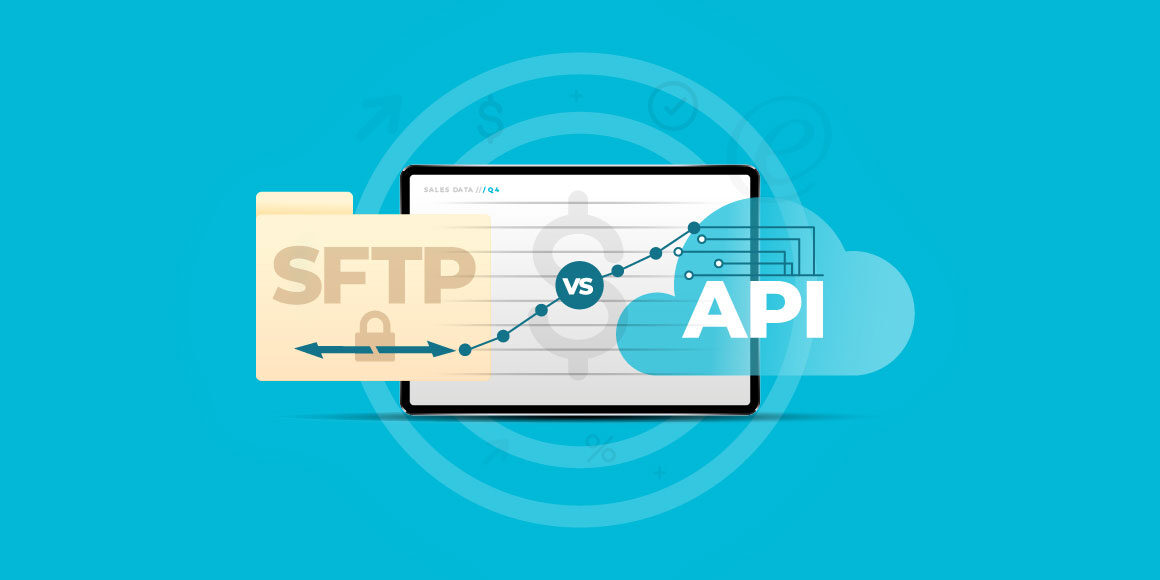Data. It’s the key to targeted sales and marketing efforts. It’s the (not-so-secret) sauce to the customized user journeys that consumers have grown to not only love but expect.
This becomes especially crucial in customer-facing activities such as complex rebate programs or pricing strategy. Rebate programs require intricate operations, demanding access to a vast array of rebate information. In addition to customer relationships, data integration is also essential for your sales channel and channel partner operations.
However, clumsy management can impact the accuracy, efficiency, and security of your data usage. In fact, securely transferring large datasets while maintaining data integrity and accessibility is a constant challenge for businesses.
That's where SFTP (Secure File Transfer Protocol) and API (Application Programming Interface) integration come into play.
SFTP is a network protocol that enables secure and encrypted file transfers between a client and a server. SFTP runs on the SSH (secure shell) protocol and supports full security and authentication when sending and managing large files and sensitive data. It is commonly used in industries where data security is of utmost importance.
API integration provides close-to-real-time insights, seamless connectivity, secure transmission and access control. It connects software systems and applications through Application Programming Interfaces, meaning that businesses can synchronize data and automate workflows.
But which is right for you? That’s what we’re helping you answer. We’re covering:
- SFTP Integration for Record Sharing: An Overview
- API Integration for Record Sharing: An Overview
- Use Cases
- Tools, Maintenance, and Reporting
Then, we're going to specifically look at how SFTP and API integrations play a role in your rebate management process and operations with channel partners:
- Data Integration + Rebate Management
- Choosing the Right Data Integration and Rebate Management System
- Data Integration with Channel Partners: APIs vs. SFTP
Finally, we're going to explore the how these integrations should factor into your chosen software solutions:
- Choosing the Right Data Integration and Rebate Management Software Solution
Let’s dive in!
SFTP Integration for Record Sharing: An Overview
Many businesses collect and store vast amounts of customer data, ranging from personal information to transaction history. To efficiently integrate this data with other systems or perform analytics, it often needs to be transferred securely between different applications or databases.
SFTP provides a reliable and secure method for moving these large datasets in a batch format. By using SFTP, businesses can ensure that sensitive customer information remains protected during the transfer process. The use of secure shell encryption adds an extra layer of security, safeguarding the data from unauthorized access or interception.
Moreover, SFTP offers features such as compression and integrity checks, which further enhance the reliability and accuracy of data transfers. This ensures that the integrated data is complete and intact, without any corruption or loss.
The advantages of integrating SFTP for record sharing include:
- Secure File Transfer: SFTP provides a straightforward and widely adopted method for transferring files securely between systems or servers.
- Batch Processing: SFTP is particularly suitable for large-scale data transfers, allowing for efficient batch processing of records.
- Data Control: With SFTP, users have the ability to inspect files and validate imports, ensuring data accuracy and integrity.
- Wide Compatibility: As a standard protocol, SFTP is supported by various platforms, making it compatible and accessible across different systems.
- Reduced Development Overhead: Compared to API integrations, SFTP integration tends to be simpler and requires fewer resources, resulting in reduced development overhead.
- Quicker Speed to Market: From an Information Security and data governance perspective, SFTP integration often allows for faster deployment and implementation.
However, there are also some limitations to consider:
- Timing: SFTP transfers data at specific intervals rather than in real-time, which may not be suitable for applications requiring immediate updates.
- Limited Data Interaction: While SFTP excels at file transfers, it may lack the capabilities for sophisticated data interactions that APIs offer.
- Security Risks: Managing and securing file access in SFTP integrations can be more challenging compared to API integrations, requiring additional security measures and protocols.
- Manual Processes: SFTP integrations may involve more manual handling, potentially introducing human errors into the data transfer process.
- Scalability Challenges: As data volume and the number of files increase, SFTP integrations may become less efficient and more difficult to manage, posing scalability challenges.
It's important to weigh these factors when considering SFTP integration for record sharing, taking into account specific use cases, security requirements, and scalability needs.
API Integration for Record Sharing: An Overview
API integration plays a crucial role in ensuring the smooth transmission of customer records, providing real-time updates, and facilitating direct system communication. By integrating APIs, businesses can synchronize data across multiple systems, ensuring that information remains consistent and up-to-date.
With API integration, businesses can unlock the full potential of their data, harnessing its value for better decision-making and operational efficiency. It allows businesses to streamline processes, eliminate manual data entry, and automate workflows, ultimately driving revenue growth and improving the overall customer experience.
The benefits of API integration for record sharing include:
- Timing: Immediate updates after each customer interaction.
- Specificity: Exchanging information about or supplemental to specific data elements, such as an account, contact or opportunity record in a CRM.
- Seamless Connectivity: Smooth and continuous data flow between applications.
- Secure Transmission and Access Control: APIs often use authentication and authorization mechanisms for secure data transfer.
- Flexibility: APIs support complex data requests and responses.
- Error Handling: Detailed error messages simplify troubleshooting.
- Business Logic Integration: APIs can be integrated directly with an application's business logic.
However, as is true with SFTP, there are some drawbacks. These include:
- Significant development complexity and effort: Requires technical expertise to build, expand, integrate, and maintain.
- API Versioning: Backward compatibility management can be challenging.
- Rate Limiting: Many APIs impose rate limits in order to prevent abuse and ensure fair usage.
- Rate limits could be based on the number of requests made in a specific time window (i.e., per hour) or throttling the number of record requests (i.e., capacity of records returnable via API).
- Payload Size: APIs often have limitations on the size of the payload (data) that can be sent in a single request. If you are dealing with a large amount of data, it may need to be split into smaller batches to fit within these constraints.
- Data Consistency: Real-time API integrations may experience data inconsistencies.
- Processing Time: When handling bulk data through APIs, the processing time on the server-side can increase significantly. This could lead to longer response times or even timeouts if the API cannot handle the large request efficiently.
- Third-Party Service Dependence: Disruptions can occur if the API provider experiences downtime or changes their API.
Use cases for SFTP integration
SFTP integration offers several recommended use cases that leverage its strengths in secure file transfer.
Data Migrations
SFTP is well-suited for data migration projects, where large volumes of customer information need to be transferred securely between systems. It provides a reliable and efficient method for transporting data during migration processes. Whether it's migrating data to a new system or consolidating data from different sources, SFTP integration ensures smooth and secure data transfer.
Historical Data Imports
When businesses need to import historical data into their systems, SFTP integration can be a valuable tool. It allows for the transfer of large files containing historical data, ensuring that the information is accurately and securely imported. With SFTP, businesses can efficiently bring in past data for analysis, reporting, or compliance purposes.
Regular Data Warehousing Activities
SFTP integration is commonly used for regular data warehousing activities, especially when dealing with large volumes of customer information. By using SFTP, businesses can easily transfer data to a data warehouse for storage and analysis purposes. Regular transfers of data from various sources to a central data warehouse ensure that businesses have access to accurate and up-to-date information for business intelligence and decision-making.
Large File Transfers
SFTP is highly effective when transferring large files that cannot be easily sent through other methods. It ensures secure and efficient transfer of files. Whether it's sharing large multimedia files, software updates, or data backups, SFTP integration provides a reliable solution for transferring large files quickly and securely.
Data Backup
SFTP integration is often utilized for regular data backup activities. By setting up automated SFTP transfers, businesses can ensure that their important data is backed up securely and regularly. SFTP offers the advantage of encryption, ensuring that data remains protected during the backup process. Regular data backups are crucial for data recovery and business continuity in case of unexpected events or system failures.
Something to consider...
Data governance and compliance play a crucial role in SFTP integration. SFTP's secure data transfer mechanisms, data integrity, and non-repudiation features enhance data security and ensure compliance with regulatory standards. It enables businesses to meet file transfer compliance regulations such as HIPAA and GDPR, ensuring that information is transferred securely and in accordance with established rules and policies. By implementing data governance and compliance practices in SFTP integration, businesses can effectively manage and protect their data throughout the transfer process.
Use cases for API integration
Real-Time Data Updates
One of the key advantages of API integration is the ability to achieve real-time data updates. By integrating systems using APIs, businesses can ensure that customer information is consistently accurate and up-to-date across various platforms. This real-time synchronization allows for better decision-making, personalized customer experiences, and enhanced operational efficiency.
Event-Triggered Frequency
API integration excels when it comes to event-triggered data updates. For instance, when a customer interaction occurs or a new lead is generated, APIs can be used to instantly transmit that information between systems. This event-driven frequency ensures that data is seamlessly propagated throughout the ecosystem, enabling timely actions and improving overall business processes.
CRM Integration or Third-Party App Connectivity
API integration offers substantial benefits when integrating Customer Relationship Management (CRM) systems with other applications. By connecting your CRM with marketing automation tools, email platforms, or e-commerce systems, you can streamline workflows, optimize data visibility, and foster collaboration across different departments. Additionally, API integration facilitates connectivity with third-party applications, allowing businesses to expand their offerings and provide customers with a seamless experience across multiple platforms.
For example, integrating a CRM system with a marketing automation tool can enable automatic lead nurturing based on specific criteria. It can trigger personalized email campaigns, update customer records, and provide valuable insights into customer behavior. Similarly, integrating a CRM with an e-commerce platform can enable real-time inventory management, order tracking, and seamless customer support.
Something to consider...
Consider starting with SFTP integration and gradually transitioning to API integration over time, following a crawl-walk-run approach. SFTP is suitable for secure file transfer and can handle large volumes of data effectively. If a closer-to-real-time data exchange is required in the future, API integration can be implemented to achieve real-time updates and seamless communication between systems.
SFTP vs. API: Reporting
When deciding between API integration and SFTP, it's crucial to consider the specific requirements of your reporting and visualization goals, as both approaches offer distinct advantages depending on your specific needs and requirements.
Because API integration enables real-time or near real-time reporting, you can ensure that your reports and visualizations are always current. This instant access to data analytics allows for dynamic visualizations that can be updated in real-time as new information becomes available. API integration is particularly beneficial for applications that require timely insights, such as live dashboards or interactive analytics.
On the other hand, the excellence with which SFTP handles large datasets and generates comprehensive historical reports makes it an ideal choice for scenarios where you need to access and analyze extensive data. If you rely on historical trends and patterns for your reporting and visualization needs, SFTP provides a reliable and efficient solution.
It's worth noting that in some cases, a hybrid approach combining both API integration and SFTP may be necessary. This allows you to leverage the benefits of real-time data access while also utilizing SFTP for handling large datasets and generating historical reports.
Data Integration + Rebate Management
Data integration can mean the difference between a successful rebate promotion and a failed one. Both SFTP and API integrations are key to an efficient rebate management process. Let's explore how rebate management software solutions can optimize this process.
Consumer rebates have long been a powerful tool for businesses seeking to incentivize purchases and strengthen customer loyalty. However, managing these rebates can be complex, requiring an intricate balance between promotional design, customer experience, and financial management.
Complex rebate programs require intricate operations, demanding access to a vast array of rebate information. The rebate process needs detailed tracking, careful rebate calculations, and constant monitoring of rebate performance.
These customer rebate agreements are not just about offering attractive rebate deals. They're about building relationships with customers based on trust and reliability. An accurate rebate claim procedure ensures the rebate agreements satisfy both parties — the business and the customer.
Crucially, a robust pricing strategy relies on pricing software, which can track, analyze, and react to changes in customer behaviors, market trends, and competitive activities. This information aids businesses in developing compelling rebate deals and incentive rebate agreements that motivate customers to maintain a long-term relationship with the brand.
The precise integration of all this data is vital for more than just operational efficiency. It enables businesses to leverage customer information to make strategic, long-term plans. This turns complex rebate agreements and intricate, data-driven pricing strategies into powerful tools for achieving business goals. Thus, it is clear, that for customer-centric operations like rebate management and pricing strategy, data is indispensable.
Rebate Management Systems and Data Integration
An ideal rebate management system should have the ability to seamlessly integrate with your existing systems. This could include your CRM system, accounting system, and customer databases. Data integration through SFTP or API makes this possible, synchronizing customer information and transaction data in real time or in batches.
For instance, when a customer avails a rebate, this action can trigger an API to update the customer's records across all linked systems. Rebate information such as rebate claims, amounts, expiration dates, and eligibility rules can be synchronized. These automated updates help businesses ensure accurate rebate calculations, efficient rebate process, and improved rebate program performance.
Data Integration in Channel Partnerships: APIs vs. SFTP
Channel partnerships thrive on the seamless flow of information between trading partners. Whether it’s sharing customer data, cash flow insights, or order volumes, the ability to exchange information accurately and promptly is crucial. Effective data integration enables business partners to align their business objectives, enhance operational efficiency, and respond swiftly to sales channel dynamics.
API Integrations: Enhancing Efficiency and Collaboration
- Real-Time Data Exchange: APIs facilitate real-time data exchange, allowing sales teams to access up-to-the-minute information. This immediacy is invaluable for decision-making, particularly for pricing strategies and fraud detection, enabling partners to react quickly to changes in demand, inventory, or customer relationships. The ability to provide real-time updates ensures that all parties are working with the latest data, reducing manual data entry needs and enhancing customer loyalty.
- Co-Creation and Joint Go-to-Market Strategies: APIs support direct system-to-system communication, fostering an environment of co-creation. Sales teams can integrate their systems and processes seamlessly, collaborating on product development, data analytics, and sales initiatives. This level of integration allows business partners to execute joint go-to-market strategies more effectively, ensuring that their efforts are cohesive and mutually reinforcing, ultimately driving business growth and improving net margins.
- Scalability: APIs are highly scalable, making them ideal for partnerships looking to expand operations. As business growth occurs, APIs can easily accommodate increasing data volumes and new functionalities, such as analytics for potential revenue forecasting. This scalability ensures that the partnership can evolve and adapt to changing market conditions without significant disruptions, maintaining a single source of truth for all relevant information.
- Enhanced Collaboration: The dynamic nature of API integrations supports continuous collaboration. Partners can share data, insights, and feedback in a timely manner, enabling them to refine their strategies and operations in real-time. This agility is crucial for maintaining a competitive edge, fostering stronger customer relationships, and driving long-term success in the market.
SFTP Integrations: Secure but Less Dynamic
- Secure Data Transfer: SFTP is renowned for its secure file transfer capabilities, making it a reliable choice for handling sensitive customer data. In channel partnerships where data security is paramount, SFTP ensures that information is transferred securely, minimizing the risk of data breaches and unauthorized access.
- Batch Processing: As we've covered, SFTP operates on a batch processing model, where data is transferred at scheduled intervals. While this method is secure, it lacks the immediacy of real-time data exchange. The delays inherent in batch processing can lead to inconsistencies, impacting the efficiency of sales teams and their ability to meet business goals.
- Limited Interaction and Collaboration: The static nature of SFTP means that it does not support the same level of dynamic interaction as APIs. Partners must wait for scheduled data updates, which can slow down decision-making processes and hinder the execution of joint initiatives, ultimately affecting operational efficiency and brand loyalty.
- Manual Processes and Scalability Challenges: SFTP integrations often require more manual processes, introducing the risk of human error. Additionally, as data volumes increase, managing SFTP integrations can become cumbersome, presenting scalability challenges that hinder the partnership's growth and adaptability.
Choosing the Right Data Integration and Rebate Management Software Solution
When choosing a rebate management solution, consider the following factors:
- Assess your integration needs: Understand your specific integration requirements, such as data volumes, frequency of data transfers, and compatibility with existing systems. This will help you choose tools that align with your business needs.
- Evaluate security features: Prioritize security when selecting API integration and SFTP tools. Look for features like encryption, secure authentication methods, and compliance with industry regulations to ensure the protection of sensitive data during transfer and storage.
- Consider scalability and flexibility: Choose tools and partners that can scale alongside your business growth. Ensure that they can handle increasing volumes of data and support integrations with multiple systems. Additionally, opt for flexible tools that can adapt to future technological advancements.
- Check compatibility and ease of use: Verify that the API integration and SFTP tools are compatible with your existing systems and have user-friendly interfaces. This will streamline the integration process and reduce complexities for your team.
- Research vendor reputation: Conduct research on the reputation and customer reviews of API integration and SFTP tool vendors. Look for established providers with positive feedback regarding their reliability, support services, and product performance.
- Evaluate documentation and support: Choose tools and partners that provide comprehensive documentation, tutorials, and support resources. This will facilitate implementation and troubleshooting, ensuring a smoother integration process.
- Consider cost-effectiveness: Evaluate the cost structures of different API integration and SFTP tools and partners. Consider not only the upfront costs but also ongoing maintenance, support, and upgrade fees. Assess the value provided by each option to make an informed decision.
By integrating data, businesses can not only streamline their operations and make informed decisions, but also improve their rebate management. The right rebate management software solution can make this process simple, efficient, and accurate, leading to increased customer satisfaction and customer loyalty.
SFTP vs. API: Which Is Right for You?
Whether you opt for single record or bulk record sharing, both approaches offer distinct advantages based on your organization's specific needs. Carefully consider which data transfer method is appropriate for you: SFTP (Secure File Transfer Protocol) or API (Application Programming Interface). Your data integration will pave the way for informed decisions, streamlined operations, and enhanced customer experiences.






